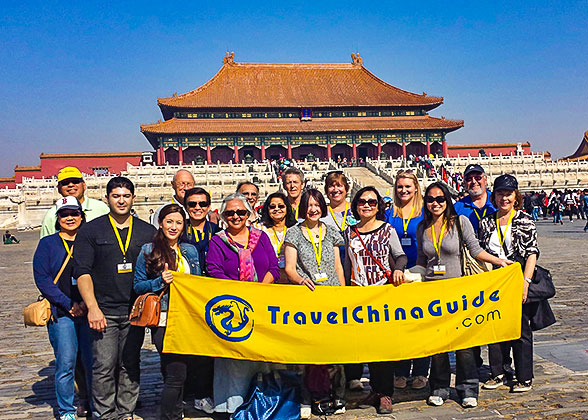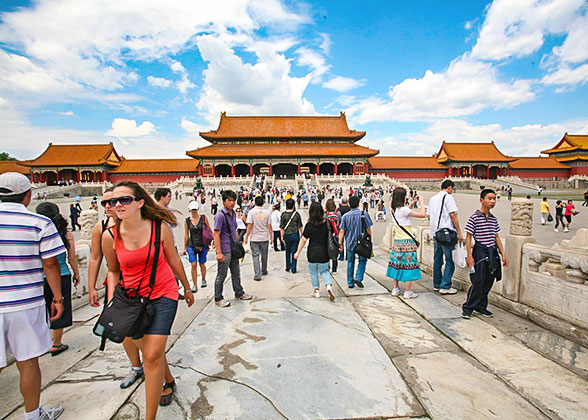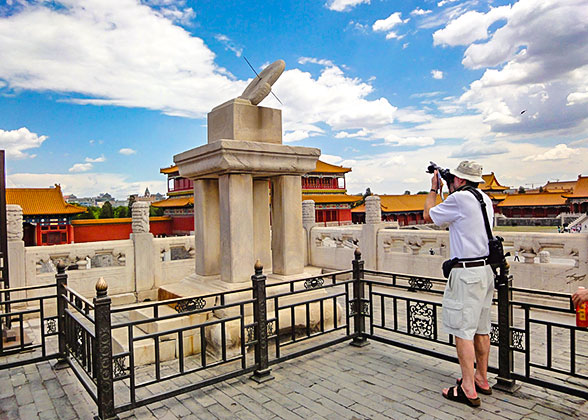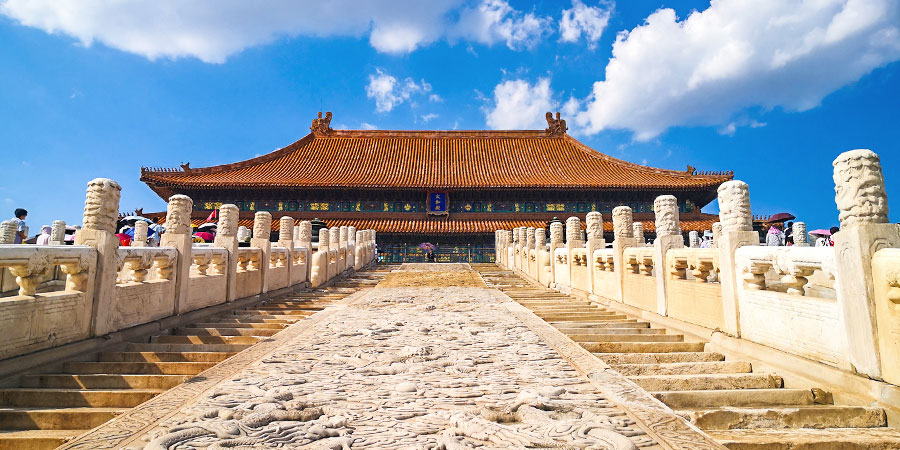Hall of Supreme Harmony (Taihedian)
After visiting the Gate of Supreme Harmony (Taihemen), one will see the Hall of Supreme Harmony (Taihedian) across a spacious square, which covers 30,000 square meters. Standing on a three-tier marble terrace, this grandest timber framework ever in China is overwhelming.
It was erected in 1406 and has undergone many later repairs. As the heart of the Forbidden City, the so-called Golden Carriage Palace, used to be the place where emperors received high officials and exercised their rule over the nation. Grand ceremonies would be held here when a new emperor ascended the throne. Celebrations also marked emperors' birthdays, wedding ceremonies and other important occasions such as the Winter Solstice, the Chinese New Year and the dispatch of generals into fields of war.
Alongside the flights of steps which ascend the three tiers of the terrace, there are eighteen bronze Dings, a kind of ancient Chinese vessel, representing the eighteen national provinces of those times. On the luxuriously balustraded terrace, stand a bronze crane and a bronze tortoise, symbols of everlasting rule and longevity. The marble Rigui, an ancient sun dial on the eastern side and the Jialiang, an ancient measuring vessel on the western side demonstrate that the emperor was both just and fair. In front of it, there are a couple of gilded bronze vats, which were used to hold water in case of fire.
Since it was symbol of the imperial power, it was the highest structure in the empire during the Ming and Qin dynasties. No other building was permitted to be higher any where in the empire. The heavily glazed hall is 35.02 meters high (37.44 meters including the rooftop decoration). It is 63.96 meters in width and 37.2 meters in length respectively. There is a total of 72 pillars, in six rows, supporting the roof. The doors and windows are embossed with clouds and dragons.
Inside of it, the floor is paved with special bricks which were fired long and then polished by being soaked in tungoil. As a symbol of imperial power, the sandalwood throne, standing on a two-meter high platform, is located in the center and surrounded by six thick gold-lacquered pillars decorated with dragons. Dragons are carved all over the golden throne. Around the throne stand two bronze cranes, an elephant-shaped incense burner and tripods in the shape of mythical beasts. It is heavily decorated with dragons, giving an aura of solemnity and mystery. In the middle of the ceiling is the design of two dragons playing with pearls. They were made of glass and painted with mercury. The pearl was said to be able to detect a usurper of the imperial power. If anyone who was not the descendant of the Emperor Huang Di usurped the throne, the pearl would drop down and strike him dead.
 Next:
Next:
It was erected in 1406 and has undergone many later repairs. As the heart of the Forbidden City, the so-called Golden Carriage Palace, used to be the place where emperors received high officials and exercised their rule over the nation. Grand ceremonies would be held here when a new emperor ascended the throne. Celebrations also marked emperors' birthdays, wedding ceremonies and other important occasions such as the Winter Solstice, the Chinese New Year and the dispatch of generals into fields of war.
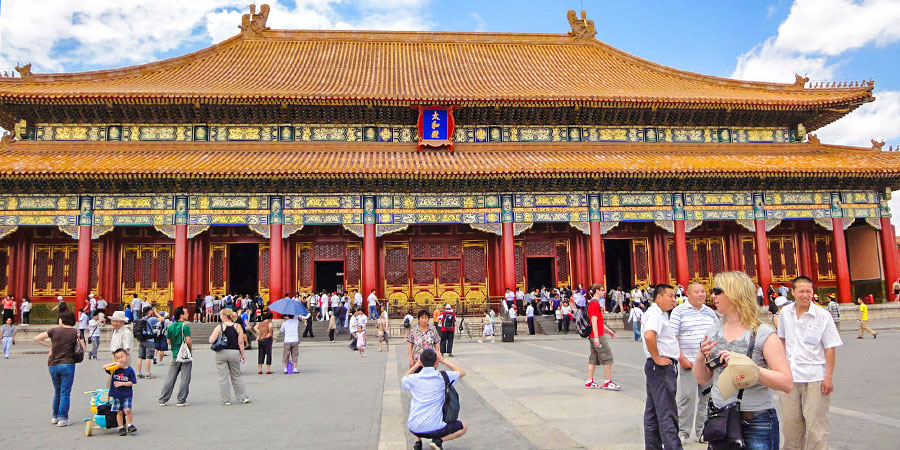 |
Alongside the flights of steps which ascend the three tiers of the terrace, there are eighteen bronze Dings, a kind of ancient Chinese vessel, representing the eighteen national provinces of those times. On the luxuriously balustraded terrace, stand a bronze crane and a bronze tortoise, symbols of everlasting rule and longevity. The marble Rigui, an ancient sun dial on the eastern side and the Jialiang, an ancient measuring vessel on the western side demonstrate that the emperor was both just and fair. In front of it, there are a couple of gilded bronze vats, which were used to hold water in case of fire.
|
|
Since it was symbol of the imperial power, it was the highest structure in the empire during the Ming and Qin dynasties. No other building was permitted to be higher any where in the empire. The heavily glazed hall is 35.02 meters high (37.44 meters including the rooftop decoration). It is 63.96 meters in width and 37.2 meters in length respectively. There is a total of 72 pillars, in six rows, supporting the roof. The doors and windows are embossed with clouds and dragons.
|
|
Inside of it, the floor is paved with special bricks which were fired long and then polished by being soaked in tungoil. As a symbol of imperial power, the sandalwood throne, standing on a two-meter high platform, is located in the center and surrounded by six thick gold-lacquered pillars decorated with dragons. Dragons are carved all over the golden throne. Around the throne stand two bronze cranes, an elephant-shaped incense burner and tripods in the shape of mythical beasts. It is heavily decorated with dragons, giving an aura of solemnity and mystery. In the middle of the ceiling is the design of two dragons playing with pearls. They were made of glass and painted with mercury. The pearl was said to be able to detect a usurper of the imperial power. If anyone who was not the descendant of the Emperor Huang Di usurped the throne, the pearl would drop down and strike him dead.
Go north to visit the Hall of Central Harmony (Zhonghedian).![]() Further Reading:
Further Reading:
How to visit the Forbidden City
Miraculous Sundials in the Forbidden City
Mysterious Animals on the Palace Roofs of the Forbidden City
Interesting Animal Statues in the Forbidden City
Special Caisson Ceiling Designs in the Forbidden City
Smallest Palace in the Forbidden City
- Last updated on Aug. 16, 2024 by Gabby Li -
